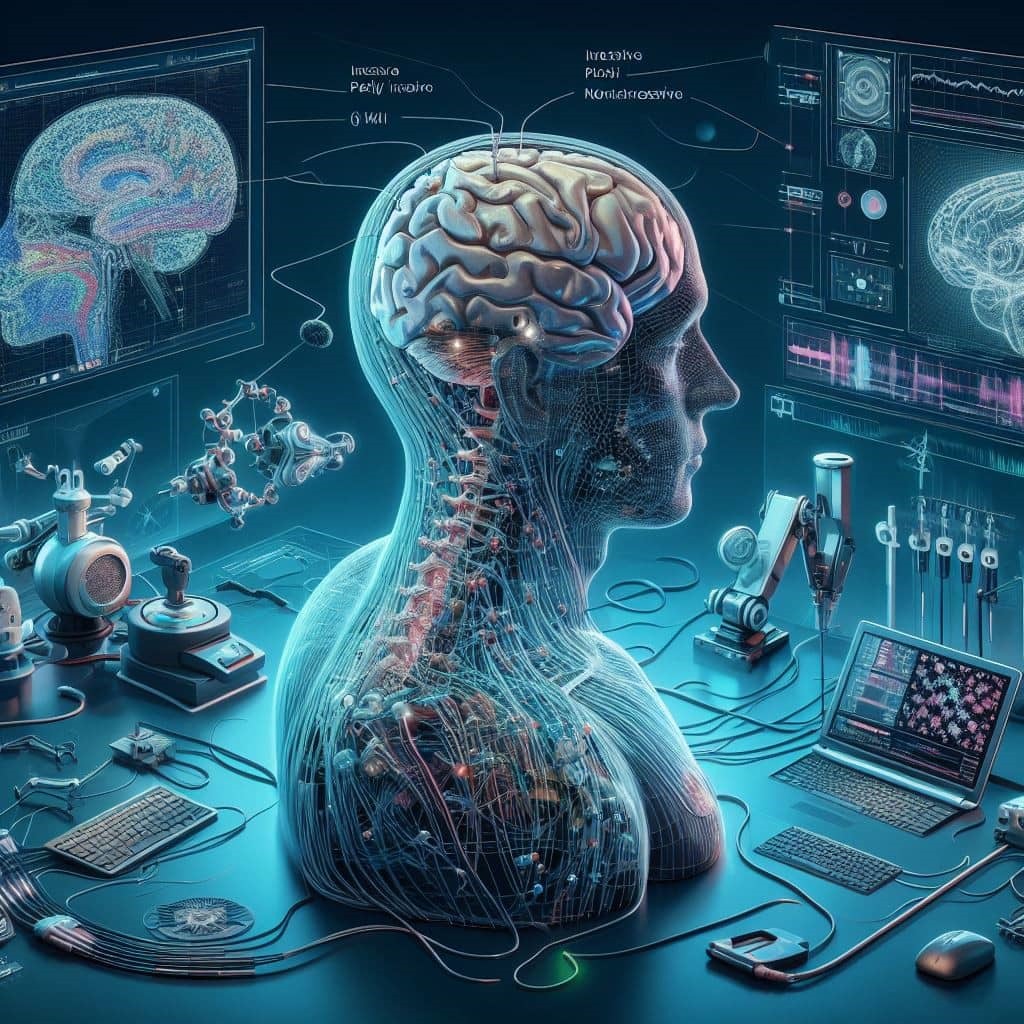Introduction
Brain-Computer Interfaces (BCIs) represent the apex of modern neuroscience and artificial intelligence (AI), forming a direct conduit between human cognition and machine intelligence. These cutting-edge systems are poised to revolutionize how we diagnose, treat, and augment brain functions, offering unprecedented opportunities to redefine the boundaries of human potential. This blog delves into the advanced mechanics of BCIs, their transformative applications, the pivotal role of AI, and the future they herald in neurology.
Understanding Brain-Computer Interfaces: A Technological Marvel
BCIs are sophisticated systems that facilitate direct communication between the brain and external devices, bypassing traditional neuromuscular pathways. Their operation is rooted in advanced neuroscience and AI integration, comprising:
- Neural Signal Acquisition: Leveraging technologies like intracranial electrodes, magnetoencephalography (MEG), or ultra-high-density EEG to capture intricate neural signals.
- Advanced Signal Processing: Utilizing deep neural networks and machine learning algorithms to decode and interpret neural activity with unparalleled precision.
- Device Integration: Connecting with external systems, such as prosthetics, exoskeletons, or even AI-driven computational systems, to execute user intentions seamlessly.
Transformative Applications of BCIs in Neurology
- Next-Generation Communication: Advanced BCIs enable individuals with complete paralysis to communicate through neural intent, bypassing physical limitations entirely.
- Hyper-Precision Prosthetics: AI-powered BCIs provide intuitive control over robotic limbs, integrating sensory feedback loops to replicate the sense of touch.
- Neuroplasticity Enhancement: Stimulating neural pathways to accelerate recovery post-stroke, brain injury, or spinal cord damage through real-time feedback systems.
- Dynamic Seizure Prediction: High-fidelity BCIs, combined with predictive AI models, provide early warnings for epileptic seizures, enhancing patient safety and autonomy.
- Advanced Cognitive Therapies: Revolutionizing the treatment of neuropsychiatric conditions like depression, OCD, and PTSD by modulating neural activity with pinpoint accuracy.

The Crucial Role of Artificial Intelligence in BCIs
AI serves as the core enabler of modern BCIs, pushing the boundaries of what is achievable through:
- Neural Data Decoding: Employing transformer-based models to analyze and decode vast neural data streams, enabling real-time operation.
- Personalized Neural Models: Adaptive learning mechanisms tailor BCI responses to individual neural profiles, enhancing both precision and usability.
- Closed-Loop Systems: AI-driven closed-loop BCIs deliver instantaneous feedback to users, fostering improved outcomes in motor control and rehabilitation.
- Scalable Cloud Integration: Cloud-based AI platforms facilitate continuous updates and global accessibility, democratizing advanced BCI technology.
Ethical Frontiers and Societal Implications
As BCIs advance, ethical considerations become paramount. Key areas requiring robust frameworks include:
- Neural Privacy: Safeguarding sensitive neural data from unauthorized access and potential misuse.
- Informed Consent in Vulnerable Populations: Ensuring transparency and autonomy for users, particularly those with severe disabilities.
- Cognitive Sovereignty: Addressing concerns over external manipulation of thoughts or behaviors via BCIs.
- Global Accessibility: Bridging the digital divide to ensure equitable access to transformative BCI technologies worldwide.

Overcoming Technical Challenges
Despite remarkable progress, BCIs face complex technical hurdles:
- Signal Clarity: Enhancing the resolution of neural signals to reduce noise and improve interpretation accuracy.
- Invasiveness vs. Precision: Balancing the high precision of invasive BCIs with the safety and convenience of non-invasive solutions.
- Long-Term Viability: Ensuring that BCIs remain functional and reliable over extended periods without significant degradation.
- Cross-Platform Integration: Developing BCIs that integrate seamlessly with diverse operating systems, devices, and environments.
The Future of BCIs: Unlocking Human Potential
The horizon of BCI innovation is as exciting as it is profound, with possibilities that include:
- Cognitive Augmentation: BCIs capable of enhancing memory, decision-making, and learning speeds, ushering in an era of superhuman cognition.
- Sensory Restoration: Advanced prosthetics providing realistic sensory feedback for vision, hearing, and tactile sensations.
- Brain-to-Brain Communication: Pioneering systems that facilitate direct neural interaction between individuals, redefining collaboration and communication.
- Integration with Smart Environments: BCIs interfacing seamlessly with IoT ecosystems, enabling brain-controlled smart homes, vehicles, and devices.
- Precision Medicine: AI-enhanced BCIs delivering hyper-personalized treatments based on real-time neural and physiological data.


Leave a Reply